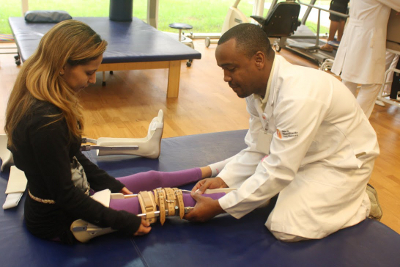
NeuroMat mathematicians and physicians collaborate to improve rehabilitation questionnaires
Mar 28, 2014
A NeuroMat interdisciplinary group is currently developing new statistical tools toward a new understanding of assessment of stroke rehabilitation, which could eventually lead to more efficient clinical tools to describe and analyze the evolution of patients. Prof. Linamara Rizzo Battistella and Dr. Marcel Simis, from the University of São Paulo's School of Medicine (FM/USP), and Prof. Verónica Andrea González-López and Prof. Jesús Enrique García, from the Institute of Mathematics, Statistics, and Scientific Computation at the University of Campinas (IME/UNICAMP), lead this research group, whose official agenda remains: “The interrelationship of clinical variables collected from stroke patients in rehabilitation.” NeuroMat is the Research, Innovation and Dissemination Center for Neuromathematics, that is coordinated by Prof. Antonio Galves and that was established in 2013 at USP, with funding from the São Paulo Research Foundation (FAPESP).
The triggering of this NeuroMat interdisciplinary group was the understanding that clinical stroke-rehabilitation evaluations could be made more efficient. The current typical measuring of patient evolutions depends on at least three scales (Fugl Meyer, Stroke Impact Scale and Wolf Motor Function Test), involving the work of several specialists from different fields, in regular sessions that remains a burden both for the clinical team and patient. Some clinical tests could take up to four days for a single patient, and this testing period could be reduced with new questionnaires. Researchers hypothesized that these scales were statistically redundant and that they could be replaced by new technologies, such as robots that allows a more precise and quickly evaluation and improved questionnaires.
The new evaluations that are being created could also be more compatible with the measuring of lesions with high-technology medical equipment, according to Prof. Battistella, a NeuroMat principal investigator. “We are involved in a broader agenda of bringing more objectivity and precision in clinical tests,” she said.
“The goal from the perspective of mathematicians in this partnership is creating and implementing a statistical test of independence among discrete variables, which could be used with data samples of small or medium sizes,” said Prof. González-López, a NeuroMat associate investigator. “Typical methods that are used to measure independence are asymptotic, thus requiring big samples in order to guarantee reliability in the results.”
 |
The current development of these statistical tools to provide reliable independence tests with small or medium-sized samples has used data from stroke patients from the Institute of Physical Medicine and Rehabilitation, from São Paulo. This Institute is part of the Lucy Montoro Rehabilitation Network, that was officially established in 2008 and gathers health centers across the State of São Paulo and specializes in physical disabilities and potentially disabling diseases. Sample sizes that are being worked with in this research are typically of less than 45 subjects.
The NeuroMat research team that is improving rehabilitation evaluations has worked on interrelated publications. From a clinical perspective, researchers intend to bring evidence of improving efficiency in tracking the evolution of stroke patients and also present a broader clinical agenda of using new technologies for rehabilitation. This broader agenda informs two forthcoming publications by NeuroMat members: “Assessment of stroke rehabilitation: towards a more accurate method of evaluation,” to be submitted in 2014, and “A novel statistical methodology for a new understanding of assessment for stroke rehabilitation.” Another publication that is being prepared from this NeuroMat group hopes to present the mathematical contributions in the development of hypothesis testing based on the longest increasing subsequence, the statistical tool that is being used to investigate independence among variables. Prof. González-López and Prof. García have co-authored “Independence tests for continuous random variables based on the longest increasing subsequence,” accepted for publication at the Journal of Multivariate Analysis in February 2014 (a link to this paper is provided at the end of this piece), in which they have presented a test of independence for continuous variables of samples of small or medium sizes. They expect to follow up with a study on equivalent tests with discrete variables.
Link to paper
This piece is part of NeuroMat's Newsletter #2. Read more here
Share on Twitter Share on Facebook| NeuroCineMat |
|---|
|
Featuring this week: |
| Newsletter |
|---|
|
Stay informed on our latest news! |
| Follow Us on Facebook |
|---|




